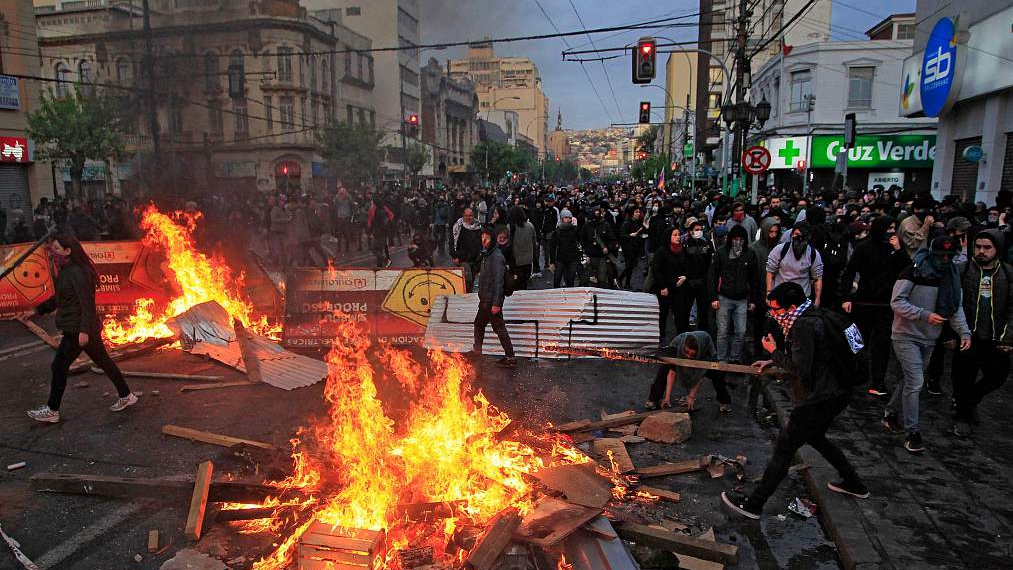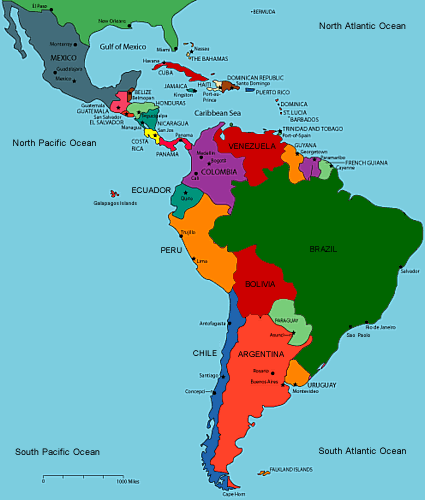
Latin America should get ready for another bumpy ride in the year ahead.
Alarm bells rang out across the region in 2019, which was marked by street protests in some nations and low or no growth almost everywhere.
No significant improvement is expected in the coming months, according to several experts.
In a newly published commentary, risk analysis firm Fitch Solutions says it does not expect 2020 will be much easier.
"The final months of 2019 have been marked by a wave of political upheaval across the region that we expect will continue to dominate the region's politics over the coming year," it says.
Another rating agency, S&P, is predicting another year of low growth for Latin America as many economies experience some of their lowest growth rates since the global financial crisis.
"We see the region growing less than two percent for a seventh consecutive year," it says.
The United Nations Economic Commission for Latin America and the Caribbean (ECLAC) projects average expansion of about 1.3 percent in 2020, an improvement on the dismal 0.1 percent it expects for this year.
"If this projection is borne out, the seven years from 2014 to 2020 will have been the slowest economic growth period in 40 years," it says.
So much then for the notion that this would be "the Latin American decade" as espoused in 2010, when the region was in the midst of a commodities boom, by Luis Alberto Moreno, the president of the Inter-American Development Bank.
Inequality a major concern
From Paraguay to Peru, Haiti to Honduras, countries have been feeling the strain of economic inertia. Even Chile, previously a poster child for Latin American prosperity, erupted in anger in 2019.

Latin America has attracted insufficient investment.
Latin America has attracted insufficient investment.
One reason is that 31 percent of Latin Americans are poor, according to UN estimates, a figure that has not changed since the start of the decade.
ECLAC notes that the political instability being experienced in some countries has not helped the overall picture. "...The growing social demands and pressures to reduce inequality and increase social inclusion have detonated with unusual intensity in some countries," is the way the agency put it.
"In our view, this instability is a reflection of the pent-up social and political tensions that are present in much of the region due to limited upward socioeconomic mobility," is S&P's take on the issue.
It fears that the bouts of unrest could continue to discourage, or at least postpone, investment in Latin America.
S&P actually blames "underwhelming levels of investment" as the main culprit for dragging growth.
ECLAC's executive secretary, Alicia Barcena, says the region needs policies to stimulate growth and lower inequality rather than structural adjustment – usually meaning fiscal restraint or outright austerity – that it "cannot withstand."
Despite the prevailing conditions, the UN agency says conditions favor the capacity to implement macroeconomic policies that would tend to reverse the current low-growth scenario. It cites historically low levels of inflation and relatively high international reserves in the region as well as access to international financial markets.
Key risk factors
In this vein, Fitch expects countries will backtrack on fiscal adjustment and pause broader pro-market reforms in 2020 as a result of the protests.
"Governments face pressure to increase social spending and public services provision, but few have the ability to significantly increase spending," it warns, adding that protests may remain a frequent and occasionally disruptive feature of the region's politics, particularly where elections are not imminent.

A demonstrator hits an armored vehicle with a stick, Quito, Ecuador, October 9, 2019. /VCG Photo
A demonstrator hits an armored vehicle with a stick, Quito, Ecuador, October 9, 2019. /VCG Photo
James Bosworth, the author of the Latin America Risk Report newsletter, is among those warning that the number and intensity of protests will increase in 2020.
"Latin America's citizens are angry at their political systems due to corruption and a lack of results on citizen security and economic promises," he wrote last month. "They are upset about inequality, low growth and the increasing cost of living."
S&P sees external factors among the key risks for Latin America going forward. "A more pronounced deceleration in real GDP growth in the major advanced economies than what we currently assume could challenge the mild economic recovery in Latin American economies," it says.
It also cautions that any further escalation in the ongoing trade dispute between the U.S. and China could renew risk aversion and lower appetite for emerging markets assets, resulting in capital outflows from Latin America.
But despite the gloom, the Economist says Latin America's so-called second "lost decade" is not as bad as the first in the 1980s when brutal right-wing administrations were in power and left-wing insurgencies were commonplace.
"None of this is to minimize Latin America's plight," the magazine cautioned, however, in a recent article. "It has to find ways to return to growth in a world where the economy is expanding more slowly, while taking bolder steps to reduce the inequality that has scarred it since long before the 1980s."
In other words, it adds, Latin America needs a new social contract for a new decade. The world watches to see whether it can deliver.
Top Photo: Demonstrators against economic conditions in Chile light bonfires in the city of Vaparaiso. Oct 19, 2019. /VCG Photo